
Bulletin 4 (II:2) 1964
Home
Français
Introduction
History
Annual Index
Author &
Subject
Credits
Contact
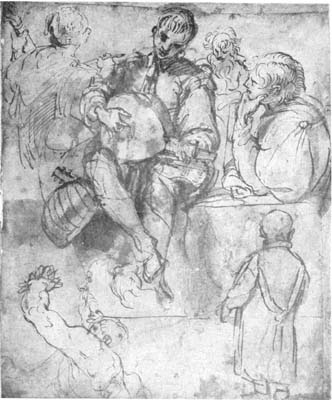
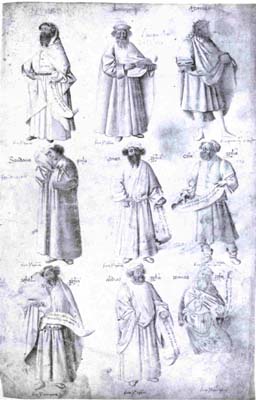
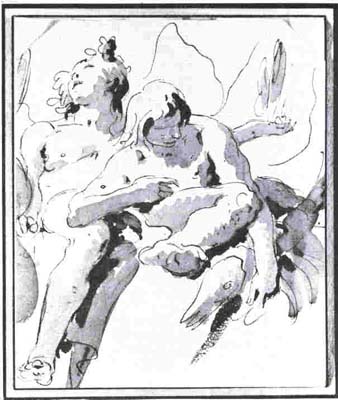
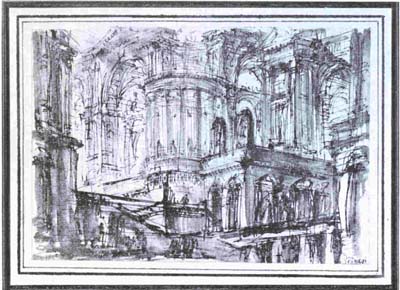
![]()
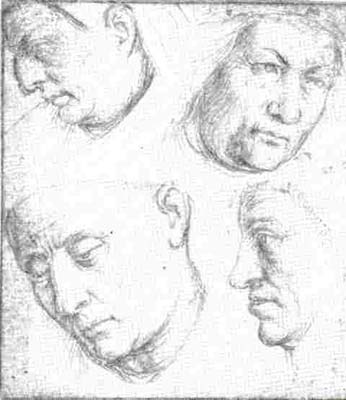
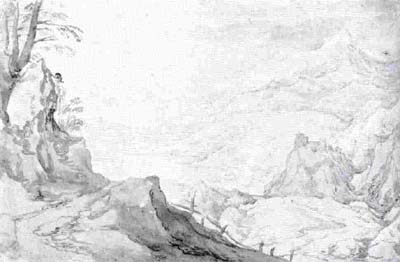
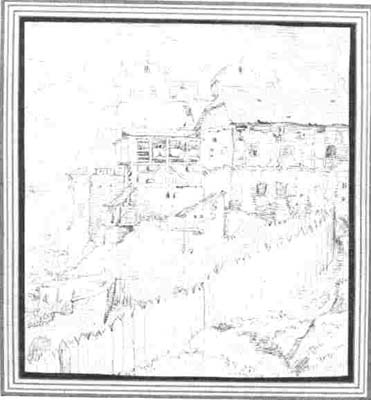
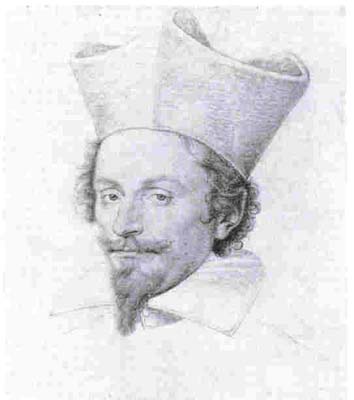
The
Collection of Drawings
by Kathleen M. Fenwick,
Curator of Prints and Drawings
Résumé en français
Page 1 | 2
| 3
The National Gallery's collection of drawings may be said to
have started in 1911 with the purchase of a group of 17 old master
drawings by the Advisory Arts Council, which had been set up by the
Government in 1907 to administer the affairs of the Gallery and
other matters related to the arts.
Few of these 17 drawings, which were bought from Gimpel and
Wildenstein in New York, who had acquired them from the Duke of
Rutland, were of much interest though one or two were of some
importance, notably an admirable sheet of studies by Annibale
Carracci (Fig. 2). The following year the Council bought some good
nineteenth-century French examples by Daubigny, Millet (Fig. 14),
Rousseau and others. After 1913, when the Gallery was incorporated
under a Board of Trustees, attention for some years was centred on
the acquisition of works by British artists. These were mostly
negligible, except for a small group of Rowlandsons and a drawing by
Augustus John.
In 1921 when the Gallery was re-opened after the war years a Print
Department was established. Here, as its name implied, the emphasis
was mainly on the building up of a representative print collection.
The founding of this department was, however, to have some bearing
on the future of the drawing collection. The drawings, such as they
were, were now in its care; and though purchases were for a number
of years to remain rather casual ones, a few good examples were
acquired, such as the small Gainsborough landscape (Fig. 17) from
the Fairfax Murray collection in 1922, four late Goyas (Fig. 18) in
1923, and a fine early Turner water colour in 1924. But the Gallery
could as yet hardly claim to have a drawing collection. Rather, it
had a few isolated and for the most part undistinguished examples
which seemed to have been acquired mainly by accident rather than by
design.
With the general growth of interest in drawings on the part of
scholars, students and public alike, it was felt that something
should be done towards building up a representative collection
worthy of a National Gallery with an already reputable collection of
paintings. So in 1937 on the advice of the then director, Eric
Brown, the Trustees appointed the late Paul Oppé to help them in
this task. As their adviser he was authorized to make purchases for
the Gallery up to an agreed annual amount without reference to the
Trustees, director or curator of prints and drawings; he was thus
given complete freedom to act as he thought best, though he
sometimes consulted with them, especially on major purchases.
The collection owes much to Paul Oppé. He made his first purchase,
a handsome drawing by Fuseli (Fig. 16) the year he was appointed and
continued to buy drawings for the Gallery until his death in 1956,
except for the war years when purchases of works of art were
drastically curtailed. During his period of office he bought, in all,
341 drawings and water colours which, with a few important
exceptions, form the basis of the collection. His policy, as he
affirmed more than once, was to acquire as many major examples as
the comparatively small sums put at his disposal allowed and at the
same time to add a number of minor examples to form a study
collection for the benefit of those interested in the many varied
aspects of drawing.
Among the major Italian purchases he made were the charming little
metal-point drawing of a saint praying by Raphael and some excellent
drawings by the Carracci, Jacopo Bassano, Go B. Tiepolo, Piranesi
(Fig. 4) and others. He also added several good examples by the
Netherlands landscape artists of the seventeenth century, a fine
sheet of studies by Rubens (Fig. 10), and a number of excellent
French drawings by Lagneau, Dumonstier (Fig. 9), Bourdon, Watteau (Figo
II) and Claude, with drawings by Millet, Corot,
Toulouse-Lautrec, Gaudier-Brzeska and others to represent the later
schools.
But as was to be expected it was in his special field of interest,
the English school, on which he was universally acknowledged to be a
great authority, that Oppé made some of his best purchases. Here he
added a number of drawings and water colours by the landscape
artists Alexander Cozens, Paul Sandby, Turner, Cotman, and Girtin
and a number by those lesser-known artists of which he had such a
wide knowledge; the Fuseli drawing, already mentioned; also a superb
early Samuel Palmer and works by other artists of Blake's circle;
and drawings by Sickert, Augustus John and Epstein.
In 1960 Mr A. E. Popham, formerly Keeper of the Department of Prints
and Drawings at the British Museum, was appointed as Oppé's
successor. He has continued to purchase drawings on the same terms
and has made several important additions to the collection during
the past few years. These include among others a sheet, formerly in
the collection of Sir Sidney Cockerell, from a Florentine picture
chronicle of about 1450 (Fig. 2); two drawings by Parmigianino which
are the subject of an article in this Bulletin; and one by
Albrecht Dürer, purchased as an anonymous drawing of the Nuremberg
School which his researches have now established as being by the
German master.
Apart from the purchases made by Oppé and Mr Popham a number of
drawings have also been acquired independently from time to time,
some of them of considerable interest. Among these are two early
metal-point drawings, one from the studio of Hans Memling, (1) the
other a small page from a sketch-book, attributed to Gheeraert David
(Fig. 6); a drawing attributed to Mabuse; and several of the
eighteenth century by Huet, Lallemand, Moreau l'Ainé, Boucher and
others, and an important work by Fragonard, a recent acquisition
(Fig. 13). But for the most part these purchases have consisted of
nineteenth- and twentieth-century examples, of the French school by
Corot, (2) Degas, Ingres, Renoir, Matisse, Modigliani, Segonzac and
Picasso; of the German by Klee, Kirchner, Nolde and Schmidt-Rottluff;
and by other contemporary artists, with a view to bringing the
representation of European draughtmanship up to date.
Gifts and bequests have been few in number but fortunately have
included some of the best examples in the collection, such as the Dürer
drawing, Nude Woman with a Staff (Fig. 5), from the
Lubomirski collection, presented in 1956 by Mr Joseph H. Hirshhorn
and a group of his friends and associates; An Angel Bringing Food
to a Hermit by Boucher (Fig. 12), the gift of Mrs Samuel
Bronfman in 1957; Medea Slaying Her Children by Fragonard,
presented by the Royal Trust Company of Montreal in 1962; (3) the
Renoir drawing of Gabrielle et Jean (Fig. 15), given by M.
Martin Fabiani in 1956; studies for a Crucifixion by Rouault,
the gift of Édouard Jonas in 1951; and the Delacroix drawing, La
Barque de Dante, a recent bequest of Mrs Ruth Massey Tovell. The
collection, to which this article serves as a brief introduction, at
present consists of some six hundred and fifty drawings, and its
further growth can be expected with some confidence. A catalogue of
the European schools has been prepared by Mr Popham, which is the
source for some of the information given here. Its publication, a
long awaited event, should do much to bring the collection some of
the recognition it deserves.
Next Page | More
Images
1 | 2
| 3
Annual Index | Author & Subject | Credits | Contact
This digital collection
was produced under contract to Canada's Digital Collections program,
Industry Canada.
"Digital
Collections Program, Copyright
© National Gallery of
Canada 2001"